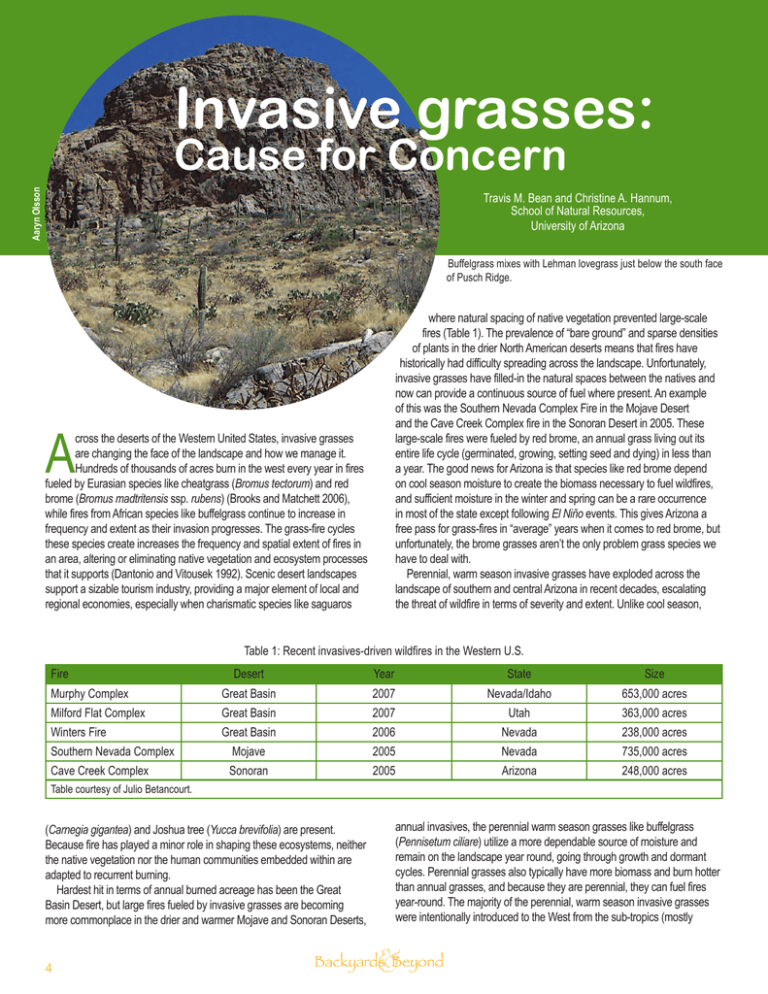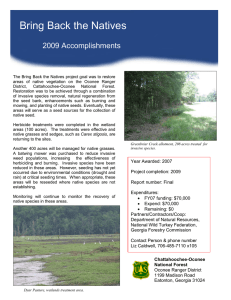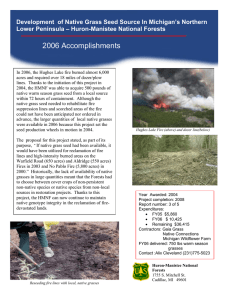Invasive grasses: Cause for Concern
advertisement

Invasive grasses: Aaryn Olsson Cause for Concern Travis M. Bean and Christine A. Hannum, School of Natural Resources, University of Arizona Buffelgrass mixes with Lehman lovegrass just below the south face of Pusch Ridge. where natural spacing of native vegetation prevented large-scale fires (Table 1). The prevalence of “bare ground” and sparse densities of plants in the drier North American deserts means that fires have historically had difficulty spreading across the landscape. Unfortunately, invasive grasses have filled-in the natural spaces between the natives and now can provide a continuous source of fuel where present. An example of this was the Southern Nevada Complex Fire in the Mojave Desert and the Cave Creek Complex fire in the Sonoran Desert in 2005. These large-scale fires were fueled by red brome, an annual grass living out its entire life cycle (germinated, growing, setting seed and dying) in less than a year. The good news for Arizona is that species like red brome depend on cool season moisture to create the biomass necessary to fuel wildfires, and sufficient moisture in the winter and spring can be a rare occurrence in most of the state except following El Niño events. This gives Arizona a free pass for grass-fires in “average” years when it comes to red brome, but unfortunately, the brome grasses aren’t the only problem grass species we have to deal with. Perennial, warm season invasive grasses have exploded across the landscape of southern and central Arizona in recent decades, escalating the threat of wildfire in terms of severity and extent. Unlike cool season, A cross the deserts of the Western United States, invasive grasses are changing the face of the landscape and how we manage it. Hundreds of thousands of acres burn in the west every year in fires fueled by Eurasian species like cheatgrass (Bromus tectorum) and red brome (Bromus madtritensis ssp. rubens) (Brooks and Matchett 2006), while fires from African species like buffelgrass continue to increase in frequency and extent as their invasion progresses. The grass-fire cycles these species create increases the frequency and spatial extent of fires in an area, altering or eliminating native vegetation and ecosystem processes that it supports (Dantonio and Vitousek 1992). Scenic desert landscapes support a sizable tourism industry, providing a major element of local and regional economies, especially when charismatic species like saguaros Table 1: Recent invasives-driven wildfires in the Western U.S. Fire Desert Year State Size Murphy Complex Great Basin 2007 Nevada/Idaho 653,000 acres Milford Flat Complex Great Basin 2007 Utah 363,000 acres Winters Fire Great Basin 2006 Nevada 238,000 acres Southern Nevada Complex Mojave 2005 Nevada 735,000 acres Cave Creek Complex Sonoran 2005 Arizona 248,000 acres Table courtesy of Julio Betancourt. (Carnegia gigantea) and Joshua tree (Yucca brevifolia) are present. Because fire has played a minor role in shaping these ecosystems, neither the native vegetation nor the human communities embedded within are adapted to recurrent burning. Hardest hit in terms of annual burned acreage has been the Great Basin Desert, but large fires fueled by invasive grasses are becoming more commonplace in the drier and warmer Mojave and Sonoran Deserts, 4 annual invasives, the perennial warm season grasses like buffelgrass (Pennisetum ciliare) utilize a more dependable source of moisture and remain on the landscape year round, going through growth and dormant cycles. Perennial grasses also typically have more biomass and burn hotter than annual grasses, and because they are perennial, they can fuel fires year-round. The majority of the perennial, warm season invasive grasses were intentionally introduced to the West from the sub-tropics (mostly & Backyards Beyond or control them, or how to get involved in the issue, contact Travis Bean (520.621.8589 or bean@email.arizona.edu). References Brooks, M. L. and J. R. Matchett. 2006. Spatial and temporal patterns of wildfires in the Mojave Desert, 1980-2004. Journal of Arid Environments 67:148-164. Clarke, P. J., P. K. Latz, and D. E. Albrecht. 2005. Long-term changes in semi-arid vegetation: Invasion of an exotic perennial grass has larger effects than rainfall variability. Journal of Vegetation Science 16:237-248. Dantonio, C. M. and P. M. Vitousek. 1992. Biological Invasions By Exotic Grasses, The Grass Fire Cycle, And Global Change. Annual Review of Ecology and Systematics 23:63-87. Morales-Romero, D. and F. Molina-Freaner. 2008. Influence of buffelgrass pasture conversion on the regeneration and reproduction of the columnar cactus, Pachycereus pecten-aboriginum, in northwestern Mexico. Journal of Arid Environments 72:228-237. Aaryn Olsson Africa) for erosion control or improved livestock forage. Unfortunately, the main limitation in the expansion of these grasses is freezing temperatures, which is less of a barrier in the facing of a warming climate. Mean minimum temperatures in the cool season (Nov-Apr) have increased significantly in recent decades, so too have the infestations of invasive warm-season perennial grasses. Common examples of invasive subtropical forage grasses that have spread far and wide across Arizona and are capable of initiating grass-fire cycles are Lehmann lovegrass (Eragrostis lehmanniana), African lovegrass (E. echinochloidea), Kleberg’s bluestem (Dichanthium annulatum), and buffelgrass. Exacerbating the problem, commonly available invasive ornamnental grasses like fountain grass (Pennisetum setaceum) and natal grass (Melinis repens) continue to be sold to unsuspecting homeowners and landscapers. Rapid growth, abundant seed production and effective seed dispersal mechanisms are common traits of these grasses that allow them to spread widely, even in undisturbed areas. When combined with their preferred climate and soils (i.e. similar to the climate and soils in the plant’s area of origin), those traits make these grasses a powerful force for undesirable and, at times, dangerous ecological changes, having profound and irreversible effects on local biodiversity (ecosystem structure) as well as ecological goods and services (ecological functioning) such as nutrient cycling and the transport, supply and quality of water and sediment due to shifts in erosion associated with frequent and extensive fires in a newly-flammable landscape. Research has repeatedly shown that increased abundance of invasive grasses is associated with decreased native species richness (Clarke et al. 2005). In the case of long-lived desert plants, such as the saguaro and littleleaf palo verde (Parkinsonia microphylla), a decrease in the success of new seedlings caused by competition from invasive grass species can result in limited recruitment and possibly a loss of entire generations of plants (Morales-Romero and Molina-Freaner 2008). The spatial extent of the invasion and the ecological and economic damage associated with invasive grasses argues for swift, comprehensive, and coordinated control. These invasions and their consequences are regional problems, therefore, they require a regional, crossjurisdictional approach to management including the support and participation of private citizens. First and foremost, homeowners should be aware of what they are planting in their yards and avoid non-native grasses like fountain grass and natal grass. Second, the methods for small-scale control of these grasses and the tools are widely available- take the time to be a good neighbor and remove invasive grasses from your property if they are present. Third, join one of the several Sonoran Desert Weedwackers volunteer groups by donating your time and help remove invasive grasses. Check out www.buffelgrass.org for volunteer group meeting locations and times. If you have a homeowners’ association where you live, encourage the HOA to take action to remove these grasses from common properties or organize a neighborhood “grass pull”. If the HOA already has a contract with a landscaping firm, encourage the HOA to modify the contract to emphasize the removal of invasive grasses. For more information on invasive grasses, how to correctly identify Large patch of buffelgrass overlapping the lowest extents of the Aspen Fire (the "smooth" looking area in the center of the frame). Note that smaller patches follow the slope down to the right (out of picture) and into the foreground near Catalina Highway (off-picture to the right). Summer 2009 5






